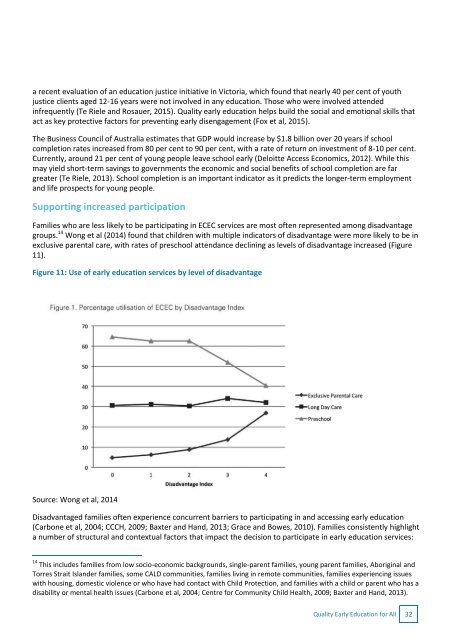Quality Early Education for All
Quality-Early-Education-for-All-FINAL
Quality-Early-Education-for-All-FINAL
You also want an ePaper? Increase the reach of your titles
YUMPU automatically turns print PDFs into web optimized ePapers that Google loves.
a recent evaluation of an education justice initiative in Victoria, which found that nearly 40 per cent of youth<br />
justice clients aged 12-16 years were not involved in any education. Those who were involved attended<br />
infrequently (Te Riele and Rosauer, 2015). <strong>Quality</strong> early education helps build the social and emotional skills that<br />
act as key protective factors <strong>for</strong> preventing early disengagement (Fox et al, 2015).<br />
The Business Council of Australia estimates that GDP would increase by $1.8 billion over 20 years if school<br />
completion rates increased from 80 per cent to 90 per cent, with a rate of return on investment of 8-10 per cent.<br />
Currently, around 21 per cent of young people leave school early (Deloitte Access Economics, 2012). While this<br />
may yield short-term savings to governments the economic and social benefits of school completion are far<br />
greater (Te Riele, 2013). School completion is an important indicator as it predicts the longer-term employment<br />
and life prospects <strong>for</strong> young people.<br />
Supporting increased participation<br />
Families who are less likely to be participating in ECEC services are most often represented among disadvantage<br />
groups. 14 Wong et al (2014) found that children with multiple indicators of disadvantage were more likely to be in<br />
exclusive parental care, with rates of preschool attendance declining as levels of disadvantage increased (Figure<br />
11).<br />
Figure 11: Use of early education services by level of disadvantage<br />
Source: Wong et al, 2014<br />
Disadvantaged families often experience concurrent barriers to participating in and accessing early education<br />
(Carbone et al, 2004; CCCH, 2009; Baxter and Hand, 2013; Grace and Bowes, 2010). Families consistently highlight<br />
a number of structural and contextual factors that impact the decision to participate in early education services:<br />
14 This includes families from low socio-economic backgrounds, single-parent families, young parent families, Aboriginal and<br />
Torres Strait Islander families, some CALD communities, families living in remote communities, families experiencing issues<br />
with housing, domestic violence or who have had contact with Child Protection, and families with a child or parent who has a<br />
disability or mental health issues (Carbone et al, 2004; Centre <strong>for</strong> Community Child Health, 2009; Baxter and Hand, 2013).<br />
<strong>Quality</strong> <strong>Early</strong> <strong>Education</strong> <strong>for</strong> <strong>All</strong> 32


